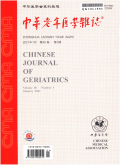老年2型糖尿病患者心电图校正QT间期延长与颈动脉粥样硬化的相关性
Correlation between QTc interval prolongation on the electrocardiogram and carotid atherosclerosis in elderly patients with type 2 diabetes mellitus
摘要目的:探讨老年2型糖尿病患者心电图校正QT(QTc)间期延长与颈动脉粥样硬化的相关性。方法:回顾性收集2016年2月至2019年2月我院收治的212例老年2型糖尿病患者的临床资料,按照颈动脉内膜中层厚度(CIMT)分为CIMT≥1.0 mm组(110例)和CIMT<1.0 mm组(102例)。同时依据QTc间期将患者分为QTc间期延长组(QTc间期>440 ms,50例)和QTc间期正常组(QTc间期≤440 ms,162例)。比较各组临床资料差异,采用Logistic回归方程分析颈动脉粥样硬化的相关因素。结果:与CIMT<1.0 mm组患者比较,CIMT≥1.0 mm组年龄、病程、收缩压、空腹血糖、三酰甘油、血肌酐、血尿酸、C反应蛋白水平较高(均 P<0.05)。CIMT≥1.0 mm组QTc间期(419.2±42.6)ms,长于CIMT<1.0 mm组(396.5±45.2)ms( t=3.849, P<0.01)。QTc间期延长组CIMT(1.2±0.3)mm高于QTc间期正常组(0.9±0.3)mm( t=6.956, P<0.01)。QTc间期延长组颈动脉粥样硬化、内膜增厚、粥样斑块检出率分别为76.0%(38例)、32.0%(16例)和44.0%(22例),高于QTc间期正常组的44.4%(72例)、18.5%(30例)和25.9%(42例),差异有统计学意义( χ2=15.239、4.087和5.922,均 P<0.05)。Pearson相关性分析显示CIMT与年龄、病程、收缩压、空腹血糖、三酰甘油、血肌酐、血尿酸、C反应蛋白、QTc间期呈正相关(均 P<0.05)。多因素Logistic回归分析显示,QTc间期>440 ms的老年2型糖尿病患者发生颈动脉粥样硬化的风险是QTc≤440 ms患者的1.761倍( OR=1.761,95% CI:1.460~3.126, P<0.01)。 结论:QTc间期延长与老年2型糖尿病患者颈动脉粥样硬化相关,应重视心电图QTc间期的检测评估颈动脉粥样硬化的发生风险。
更多相关知识
abstractsObjective:To investigate the correlation between the prolongation of the QTc interval and carotid atherosclerosis in elderly patients with type 2 diabetes mellitus(T2DM).Methods:CIinical data of 212 elderly patients with T2DM admitted to our hospital from February 2016 to February 2019 were retrospectively collected.Based on carotid intima-media thickness(CIMT), patients were divided into the CIMT≥1.0 mm group(n=110)and the CIMT<1.0 mm group (n=102). Meanwhile, patients were divided into the prolonged QTc interval group(QTc interval>440 ms, n=50)and the normal QTc interval group(QTc interval≤440 ms, n=162), base on the adjusted QTc interval.General clinical data were compared between the groups, and the logistic regression equation was used to analyze the related factors for carotid atherosclerosis.Results:Higher values of age, duration of disease, systolic blood pressure(SBP), fasting plasma glucose(FPG), triglycerides(TG), creatinine(Cr), uric acid and C-reactive protein(CRP)were found in the CIMT≥1.0 mm group than in the CIMT<1.0 mm group( P<0.05). The QTc interval was longer in the CIMT≥1.0 mm group than in the CIMT<1.0 mm group[(419.2 ± 42.6) ms vs. (396.5 ± 45.2) ms, t=3.849, P<0.01]. CIMT was greater in the prolonged QTc interval group than in the normal QTc interval group[(1.2± 0.3)mm vs.(0.9±0.3) mm, t=6.956, P<0.01]. The detection rates of carotid atherosclerosis, intimal thickening and atheromatous plaques were higher in the prolonged QTc interval group than in the normal QTc interval group( 76.0% or 38 vs. 44.4% or 72, 32.0% or 16 vs.18.5% or 30 and 44.0% or 22 vs.25.9% or 42, respectively, χ2=15.239, 4.087 and 5.922, P<0.05). Pearson’s correlation analysis showed that CIMI was positively correlated with age, duration of disease, SBP, FPG, TG, Cr, uric acid, CRP and QTc interval( P<0.05). Multivariate logistic regression showed that the risk of carotid atherosclerosis in patients with QTc interval>440 ms was 1.761 times higher than that in patients with QTc≤440 ms( OR=1.761, 95% CI: 1.460-3.126, P<0.01). Conclusions:QTc interval prolongation is correlated with carotid atherosclerosis in elderly patients with T2DM, and attention should be paid to the QTc interval on the electrocardiogram, which is helpful to assess the risk of carotid atherosclerosis in elderly T2DM patients.
More相关知识
- 浏览0
- 被引5
- 下载0


相似文献
- 中文期刊
- 外文期刊
- 学位论文
- 会议论文



 换一批
换一批 换一批
换一批



